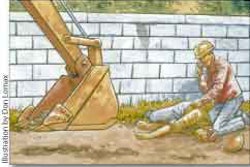Treacherous trenching
Knowing the guidelines keeps you out of harm’s way

The bottom line: A post-accident investigation determined the sides of the trench were not properly sloped, and no shoring or trench box was used. The investigation also found large spoil piles and an excavator weighing 12 metric tons were placed at the edge of the trench while workers were inside.
Recognize the danger. Understand the mechanics of how a collapse occurs. As soil is removed from the ground, pressure is generated on the face of the trench. Additional weight at the edge from soil or equipment will further increase the pressure on the trench wall. Without support or proper sloping, the wall will shear and break away, causing soil to fall into the hole. Depending upon the soil composition, a cubic yard of soil can weigh more than 2,500 pounds.
Know the requirements. Check the depth of a trench before you enter. If it is more than 5 feet deep, OSHA requires your employer to have a protective system – sloping, shoring or shielding – in place. If the trench is deeper than 20 feet, a registered professional engineer must design the system. Look along the trench to ensure no spoil piles or equipment has been placed within 2 feet of the edge.
Learn the plan. Your employer needs to have a trench emergency action in place that outlines how rescue attempts will proceed, while ensuring the safety of others. In the event of a trench collapse, dial 911 to request emergency assistance first, and then call your supervisor and advise him of the situation. Remember that trench rescue is one of the most dangerous types of rescue operations, and do not attempt to participate unless you are fully trained to do so. In addition to putting your own life in danger, you also risk causing more soil to collapse onto the victim or rescue workers.
To become more familiar with trench collapses, view the National Institute for Occupational Safety and Health’s web-based training at https://www.cdc.gov/niosh/docs/2006-133d/ and click on “View the Trench Safety Awareness Web-based training.” A simple tips card you can share with fellow workers can be found on the OSHA website here: http://www.osha.gov/Publications/trench/trench_safety_tips_card.pdf. EW
Information for this Safety Watch came from an accident report, OSHA and the Center for Disease Control’s NIOSH program. It is to be used for general information only.














